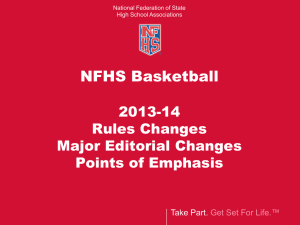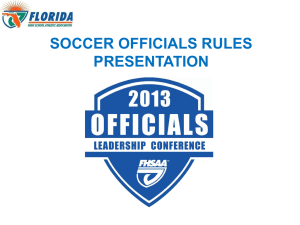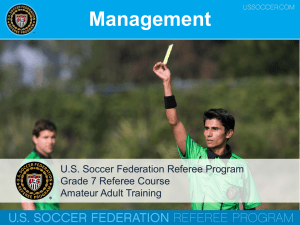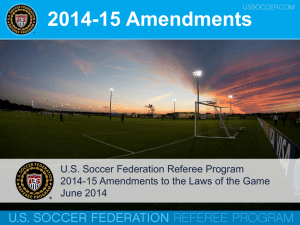Rule-Changes-2013-2014-PART-1
advertisement
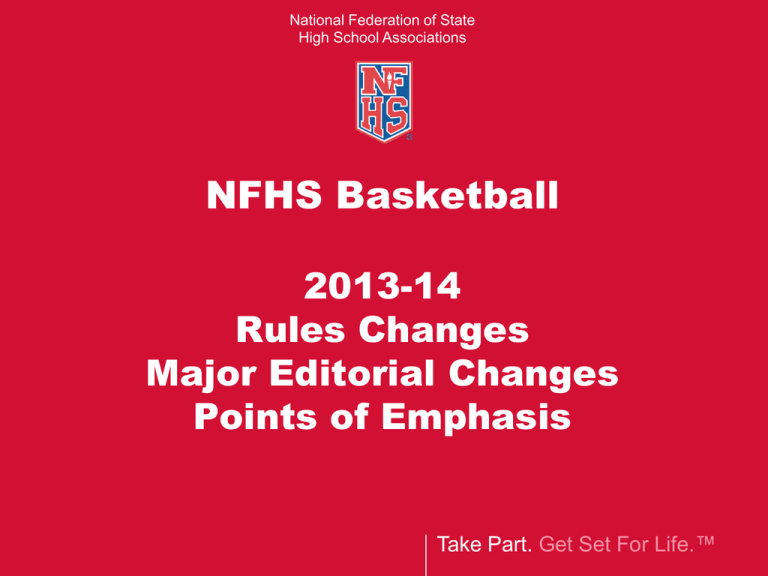
National Federation of State High School Associations NFHS Basketball 2013-14 Rules Changes Major Editorial Changes Points of Emphasis Take Part. Get Set For Life.™ National Federation of State High School Associations NFHS Basketball 2013-14 Rules Changes Take Part. Get Set For Life.™ Electronic Devices (1-19 New) The use of electronic devices is permitted during the game. Use of Electronics on the Bench Rule 1-19 RULE CHANGE PlayPi c® PlayPi c® LEGAL LEGAL A. The use of electronic devices are permitted during the game. B. Use of a tablet courtside for coaching purposes is permitted. © REFEREE ENTERPISES INC. 2013 Visible Manufacturer’s Logo/Trademark/Reference 3-4-2a A single visible manufacturer's logo/trademark/reference is permitted on the team jersey, not to exceed 2 1/4 square inches with no dimension more than 2 1/4 inches. The manufacturer's logo may be located no more than 5 inches below the shoulder seam on the front of the jersey, or 2 inches from the neckline on the back of the jersey; or in either side insert. RULE CHANGE Manufacturer’s Logo Rule 3-4-2a LEGAL ILLEGAL © REFEREE ENTERPISES INC. 2013 Manufacturer’s Logo Rule 3-4-2a PlayPi c® RULE CHANGE PlayPi c® LEGAL ILLEGAL © REFEREE ENTERPISES INC. 2013 Leg Compression Sleeve Rquirement (3-5-3) The specifications for leg compression sleeves were added because of the frequent use of these sleeves for non-medical reasons. The specifications match those of arm compression sleeve. They must be white, black, beige, or a single solid school color. The sleeve must be the same color for each team member and have only a single manufacturer's logo that does not exceed 2 1/4 square inches. The sleeve must be worn for medical reasons only. Player Equipment Rule 3-5-3 RULE CHANGE PlayPi c® PlayPi c® Arm compression sleeves and leg compression sleeves shall be white, black, beige or a single solid school color. Each team member should wear the same color compression sleeve. © REFEREE ENTERPISES INC. 2013 A Team Shall Not: (10-1-3) Use a megaphone or any electronic communication device at courtside, or electronic equipment for voice communication with players on the court. Use electronic audio and /or video devices to review a decision of the contest officials. Electronic Equipment Rule 10-1-3 RULE CHANGE PlayPi c® PlayPi c® ILLEGAL PlayPi c® ILLEGAL PlayPi c® ILLEGAL LEGAL © REFEREE ENTERPISES INC. 2013 The Head Coach May Enter the Court: (10-4-5 Note) The head coach may enter the court in the situation where a fight may break out or has broken out to prevent the situation from escalating. Fighting Rule 10-4-5 RULE CHANGE PlayPi c® PlayPi c® A. The head coach may enter the court to diffuse a situation where a fight may break out or has broken out to prevent it from escalating. B. Assistant coaches or players who enter the court will be charged with flagrant technical fouls and disqualified. © REFEREE ENTERPISES INC. 2013 Signal Chart Added a mechanic of a defensive tip (brushing one hand over the other above the head) to indicate the official has ruled the ball entered the backcourt as a result of contact with a defensive player. MANUAL CHANGES New Signal PlayPi c® PlayPi c® Brushing one hand over the other indicates that an official has ruled the ball entered the backcourt as a result of contact with a defensive player © REFEREE ENTERPISES INC. 2013 National Federation of State High School Associations NFHS Basketball 2013-14 Major Editorial Changes Take Part. Get Set For Life.™ Coaching Box 1-13-2 The coaching box shall be outlined outside the side of the court on which the scorer's and timer's table and team benches are located. The area shall be bounded by a line drawn 14 feet from the end line towards the mid-court. Coaching Box (cont.) 1-13-2 At this point a line drawn from the sideline toward the team bench becomes the end of the coaching box going towards the end line. From this line go another 14 feet towards the mid-court, then a line drawn towards the bench becomes the end of the coaching box closest to mid-court. Coaching Box (cont.) 1-13-2 The coaching box is 14 feet long placed in the middle of the regulation 42 feet long half court. These lines shall be located off the court and be 2 inches wide. EDITORIAL CHANGE Court Rule 1-13-2 MechaniGram® The coaching box is 14 feet long placed in the middle of the regulation 42-foot long half court. © REFEREE ENTERPISES INC. 2013 (3-5-1 Note) Each state association may, in keeping with applicable laws, authorize exceptions to NFHS playing rules to provide reasonable accommodations to individual participants with disabilities and/or special needs, as well as those individuals with unique and extenuating circumstances. (3-5-1 Note) The accommodations should not fundamentally alter the sport heighten risk to the athlete/others or place opponents at a disadvantage. EDITORIAL CHANGE Player Equipment Rule 3-5-1 Note PlayPi c® PlayPi c® Accommodations to participants with disabilities and/or special needs, made by state associations, should not fundamentally alter the sport, heighten risk to the athlete/others or place opponents at a disadvantage. © REFEREE ENTERPISES INC. 2013 (1-18) The announcer shall be prohibited from making announcements while the clock is running during the course of the contest. EDITORIAL CHANGE Announcer Rule 1-18 PlayPi c® Announcer speaking into microphone during play is not allowed. © REFEREE ENTERPISES INC. 2013 National Federation of State High School Associations NFHS Basketball 2013-14 Points of Emphasis Take Part. Get Set For Life.™ Proper Mechanics and Signals The use of proper mechanics and signals are imperative to the success of the contest and the officiating team. The signals are a means of communicating what is happening on the floor. A uniform set of signals enhances the flow of the contest. POINT OF EMPHASIS Proper Mechanics PlayPi c® PlayPi c® Player-Control Foul PlayPi c® Team-Control Foul PlayPi c® Intentional Foul PlayPi c® Double Foul Technical Foul Officials are encouraged to use only NFHS-approved mechanics during games. © REFEREE ENTERPISES INC. 2013 Granting Time-Out Officials must be diligent to recognize the calling of a timeout by the coach and determine that it is at the appropriate time. It is suggested that coaches add a visual signal to the verbal call for a time-out. Officials must know the status of the ball and whether there is player control before granting the request. POINT OF EMPHASIS Granting Time-out PlayPi c® PlayPi c® PlayPi c® PlayPi c® PlayPi c® Officials should know the situation of the game and the sequence of granting and reporting a time-out. © REFEREE ENTERPISES INC. 2013 DEAD Ball Officiating See the whole play. See the actions of all players. Don’t react too quickly that you do not see the second action or antics of a player that is inciting an opponent to react. Be aware of the whole situation so to penalize the correct player. POINT OF EMPHASIS Dead-Ball Officiating PlayPi c® PlayPi c® Officials should be alert when the ball is dead, at least one official should observe the players at all times and be ready to respond to any extra activity among players, immediately. © REFEREE ENTERPISES INC. 2013 Guidelines to Enforce Illegal Contact When contact occurs that affects the rhythm, speed, quickness and balance of the player, illegal contact has occurred. Illegal contact must be called regardless of time and score. POINT OF EMPHASIS Illegal Contact Guidelines PlayPi c® PlayPi c® Hand checking PlayPi c® Displacement Player Control Contact that impedes rhythm, speed, balance and quickness of the offensive or defensive player should be called. © REFEREE ENTERPISES INC. 2013 Intentional Foul An intentional foul is a personal or technical foul that may or may not be premeditated and is not based solely on the severity of the act. It is contact that: • Neutralizes an opponent’s obvious advantageous position. Intentional Foul (cont.) • Contact on an opponent who is clearly not in the play. • May be excessive contact. • Contact that is not necessarily premeditated or based solely on the severity of the act. POINT OF EMPHASIS Intentional Foul PlayPi c® Premeditated Contact PlayPi c® Contact with opponent not in play PlayPi c® Excessive Contact An intentional foul may be strategic to stop the clock or create a situation that may be tactically done for the team taking action. They may seem innocent in severity but without any playing of the ball it should be ruled intentional. © REFEREE ENTERPISES INC. 2013
